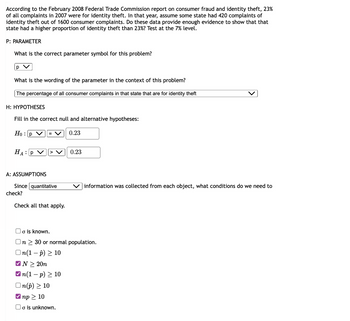
MATLAB: An Introduction with Applications
6th Edition
ISBN: 9781119256830
Author: Amos Gilat
Publisher: John Wiley & Sons Inc
expand_more
expand_more
format_list_bulleted
Question
Hello could you please help me understand the ones I left blank. Thanks much
![Check those assumptions:
z =
p
1. np =
2. n(1-p) =
3. N= 1000000
Z=
N: NAME THE PROCEDURE
The conditions are met to use a [1-Proportion Z-Test V
T: TEST STATISTIC
The symbol and value of the random variable on this problem are as follows:
Leave this answer as a fraction.
p-p
If no N is given in the problem, use 1000000
p(1-p)
72
The formula set up of the test statistic is as follows.:
(Leave any values that were given as fractions as fractions)
=
which is 2
O: OBTAIN THE P-VALUE
which is 2
P-value =
which is 2
M: MAKE A DECISION
Final answer for the test statistic from technology.
Round to 2 decimal places:
Since the p-value
10
]√√C
Report to 4 decimal places.
It is possible when rounded that p-value is 0.0000
10
0.07
-I).
we reject H
S: STATE A CONCLUSION
There is
V significant evidence to conclude
The percentage of all consumer complaints in that state that are for identity theft
is more than](https://content.bartleby.com/qna-images/question/08bb2a94-da17-43f2-90ab-4ad444df37b3/9c2d41cb-5092-44a6-9308-8a14df7d0fb0/1ri7bny_thumbnail.png)
Transcribed Image Text:Check those assumptions:
z =
p
1. np =
2. n(1-p) =
3. N= 1000000
Z=
N: NAME THE PROCEDURE
The conditions are met to use a [1-Proportion Z-Test V
T: TEST STATISTIC
The symbol and value of the random variable on this problem are as follows:
Leave this answer as a fraction.
p-p
If no N is given in the problem, use 1000000
p(1-p)
72
The formula set up of the test statistic is as follows.:
(Leave any values that were given as fractions as fractions)
=
which is 2
O: OBTAIN THE P-VALUE
which is 2
P-value =
which is 2
M: MAKE A DECISION
Final answer for the test statistic from technology.
Round to 2 decimal places:
Since the p-value
10
]√√C
Report to 4 decimal places.
It is possible when rounded that p-value is 0.0000
10
0.07
-I).
we reject H
S: STATE A CONCLUSION
There is
V significant evidence to conclude
The percentage of all consumer complaints in that state that are for identity theft
is more than

Transcribed Image Text:According to the February 2008 Federal Trade Commission report on consumer fraud and identity theft, 23%
of all complaints in 2007 were for identity theft. In that year, assume some state had 420 complaints of
identity theft out of 1600 consumer complaints. Do these data provide enough evidence to show that that
state had a higher proportion of identity theft than 23%? Test at the 7% level.
P: PARAMETER
What is the correct parameter symbol for this problem?
p V
What is the wording of the parameter in the context of this problem?
The percentage of all consumer complaints in that state that are for identity theft
H: HYPOTHESES
Fill in the correct null and alternative hypotheses:
Hop V = V
0.23
HA: P
A: ASSUMPTIONS
Since quantitative
check?
Check all that apply.
0.23
✓np > 10
□o is unknown.
Vinformation was collected from each object, what conditions do we need to
o is known.
On > 30 or normal population.
In(1 − p) ≥ 10
✔N> 20n
✔n(1-p) ≥ 10
In(p) ≥ 10
Expert Solution
This question has been solved!
Explore an expertly crafted, step-by-step solution for a thorough understanding of key concepts.
Step by stepSolved in 3 steps with 1 images

Knowledge Booster
Similar questions
arrow_back_ios
arrow_forward_ios
Recommended textbooks for you
 MATLAB: An Introduction with ApplicationsStatisticsISBN:9781119256830Author:Amos GilatPublisher:John Wiley & Sons Inc
MATLAB: An Introduction with ApplicationsStatisticsISBN:9781119256830Author:Amos GilatPublisher:John Wiley & Sons Inc Probability and Statistics for Engineering and th...StatisticsISBN:9781305251809Author:Jay L. DevorePublisher:Cengage Learning
Probability and Statistics for Engineering and th...StatisticsISBN:9781305251809Author:Jay L. DevorePublisher:Cengage Learning Statistics for The Behavioral Sciences (MindTap C...StatisticsISBN:9781305504912Author:Frederick J Gravetter, Larry B. WallnauPublisher:Cengage Learning
Statistics for The Behavioral Sciences (MindTap C...StatisticsISBN:9781305504912Author:Frederick J Gravetter, Larry B. WallnauPublisher:Cengage Learning Elementary Statistics: Picturing the World (7th E...StatisticsISBN:9780134683416Author:Ron Larson, Betsy FarberPublisher:PEARSON
Elementary Statistics: Picturing the World (7th E...StatisticsISBN:9780134683416Author:Ron Larson, Betsy FarberPublisher:PEARSON The Basic Practice of StatisticsStatisticsISBN:9781319042578Author:David S. Moore, William I. Notz, Michael A. FlignerPublisher:W. H. Freeman
The Basic Practice of StatisticsStatisticsISBN:9781319042578Author:David S. Moore, William I. Notz, Michael A. FlignerPublisher:W. H. Freeman Introduction to the Practice of StatisticsStatisticsISBN:9781319013387Author:David S. Moore, George P. McCabe, Bruce A. CraigPublisher:W. H. Freeman
Introduction to the Practice of StatisticsStatisticsISBN:9781319013387Author:David S. Moore, George P. McCabe, Bruce A. CraigPublisher:W. H. Freeman

MATLAB: An Introduction with Applications
Statistics
ISBN:9781119256830
Author:Amos Gilat
Publisher:John Wiley & Sons Inc

Probability and Statistics for Engineering and th...
Statistics
ISBN:9781305251809
Author:Jay L. Devore
Publisher:Cengage Learning

Statistics for The Behavioral Sciences (MindTap C...
Statistics
ISBN:9781305504912
Author:Frederick J Gravetter, Larry B. Wallnau
Publisher:Cengage Learning

Elementary Statistics: Picturing the World (7th E...
Statistics
ISBN:9780134683416
Author:Ron Larson, Betsy Farber
Publisher:PEARSON

The Basic Practice of Statistics
Statistics
ISBN:9781319042578
Author:David S. Moore, William I. Notz, Michael A. Fligner
Publisher:W. H. Freeman

Introduction to the Practice of Statistics
Statistics
ISBN:9781319013387
Author:David S. Moore, George P. McCabe, Bruce A. Craig
Publisher:W. H. Freeman